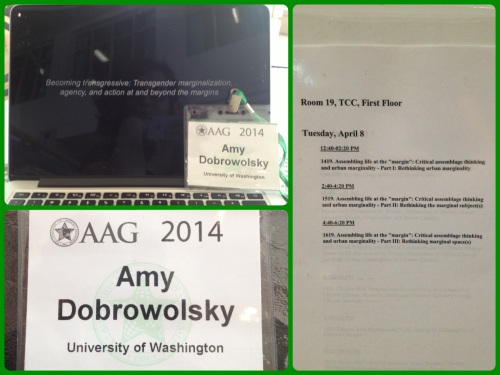
A few weeks ago, I presented my paper at the annual meeting of the Association of American Geographers (which is a misnomer as all geographers are British… and they work in Canada… so it seems.) My paper was titled Becoming transgressive: Transgender marginalization, agency, and action at and beyond the margins. Seriously, that trans- pun never gets old. As part of a panel series on assemblage thinking and urban marginality, I wanted to, first, draw several discrete categories of trans-antagonistic marginalization, which was fairly Trans 101 stuff repackaged and reconceptualized as particular assemblages (in the Deleuzian sense). Secondly, since I did not want to be a all-doom-and-gloom geographer, I wanted to identify and speculate upon several positive moves from those margins that trans people (specifically trans women) can and do make.
This was my first presentation at AAG, which is becoming my de facto “home conference” and professional organization. I’m increasingly identifying myself, professionally & academically, as a geographer–a humanistic, critical, political, philosophical, social sciencey, whatever geographer. I have my quibbles with geography; however, when I need to fly a flag of academic convenience, I use geography currently because it best addresses my varied interdisciplinary interests as coupled with my spatial interests. I’m also claiming the very specific trans-feminist geographer mantle because, well, somebody needs to do so. There are so few transfeminine perspectives in geography as well as most other humanities & social science disciplines. Moreover, the academy prepends an invisible cis to gender… as well as appending an invisible, though highly obvious, masculine to trans. This latter point was brought into stark relief at the Trans* Geographies panel, despite my overall happiness that there finally was a trans geographies panel.1 I will post more thoughts on this separately, something that will speak more to the content of my paper.
For now, however, I wanted to make a meta reflection on my presentation. Another first was that this was the first time I had actually read a paper at a conference or presentation anywhere. Since I’m a theatrical Energizer Bunny, I usually scribble down some keyword notes and stand up, walk around, and talk semi-extemporaneously. I also throw some images into a folder, rename them so they come up in presentation order, and use them to guide and underline my talk. I don’t really do Powerpoint, either. Overall, my presentations are usually free-wheeling and theatrical, though I do prepare fairly extensively.
So, this time I figured I might as well try something completely new to me at the annual meeting of the biggest organization in the discipline. I have sat through far too many incredibly dry and boring readings of papers at numerous conferences, so much so that I was starting to develop a profound distaste for the style. Thus, I wanted to see how well I could deliver carefully developed lines of written thought, in the form of reading, while still maintaining my usual lively gesticulations and engaging presentation style. Yes, guilty, I knew I could do far better at this format than others and I wanted to prove that for myself. I also wanted the practice so as to confidently add this to my arsenal2 of conference styles.
As to dry mechanics, I had no idea what preparations others take to read their papers and I didn’t really bother asking. So I printed up my final reading draft in larger point size; I wanted to make sure I could easily return to the page after looking up and/or making an off-the-cuff comment. The biggest challenge was to figure out my reading speed by timing it and subsequently editing the reading draft to the allotted time, while still retaining solid reasoning. In that sense it’s not much different from editing to a written length limit.
I also figured, since I was doing new things, to create a minimal Powerpoint. I generally dislike Powerpoint because it is done so ineffectually so often: word-heavy, distracting slides that offer contextless (afterwards) keywords enumerated as bullet points. These don’t help in the presentation and, afterwards when people send around their ppt around, I look at the slides and they look like a meaningless jumbles of words. (Note to self: I’ve never seen guidelines for trying to make presentations better for those with hearing impairments. I should look into this.)
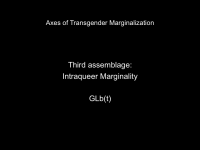
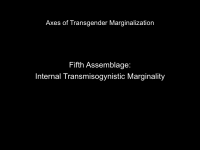
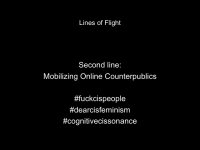
Anyway, adhering to my guideline of having less than about 6 words on a slide, I made a slide for each of my main section headers. I would display that slide while reading that section–nothing more. The only exceptions were a few sections that had an explanatory graphic. Another section had some keywords–what troublemaking trans person wouldn’t relish the chance to project #fuckcispeople and #cognitivecissonance at a conference?? Also what pretentious sot wouldn’t relish to project an Intermezzo slide while transitioning through the paper’s two major movements?? Finally, I obviously noted where to advance slides in my paper, just so that I wouldn’t forget.
One final, timed read-through and I was off to the Trans* Geographies panel, which I had just discovered that morning, occurring right before my panel. One would think that I would have researched the schedule ahead of time to see whether or not I was the only trans-related presentation.
In the end, my paper came off without a hitch. Although I timed my run-through within time, I did skip the conclusion as my moderator indicated time out; as a proper conclusion, though, it succinctly reiterated the important points of the paper. As a result, I did not feel that the presentation lost anything with its omission. And I ended on a highly poignant piece of information. Also I did my part to actually keep the panel on time.
It could just be that I’m gaining more and more confidence in general; however I had actually never felt calmer before a presentation than this one. Maybe it was the knowledge everything I wanted to say, within time limit, was on paper in front of me. But there was another level of control. I had my iPhone and was running my own timer as well, so I had a rough idea of how ahead or behind I was at a glance. Knowing this, I had marked out a few passages as “optional”. These were added examples or an extra point to make, had I the time, or things I could easily omit we’re I behind.
It was nice that the set-up involved standing at a podium rather than reading seated from the panelist’s table. Standing allowed me to move slightly around the podium area, to gesticulate, and to make unfettered eye contact to all parts of the room. Enlarging the type was a good idea, though I did briefly lose my place once I did not feel any strain in moving focus between text and the room. My notes on slide advancement were handy… on a subconscious level, I think. I knew how my paper was organized by section, so I had an innate sense of when to advance slides. Not bad for throwing it together that morning. But I’m glad the notes were there.
All in all, I am pleased with the outcome. I am pleased to know that I got this. I am pleased to know that I can read a paper and still be lively and engaging; that it feels almost as good to deliver as a more ad-libbed presentation. One point to improve upon would probably be to look up, step back from the podium slightly, and speak a little more extemporaneously about something: perhaps next time, I will do that with some of my examples, rather than reading them. I did feel I was a little less lively in my delivery than I am in other modes but not unacceptably so for me. The trade-off of having absolute confidence in my exact words was worth it when making a careful, sustained argument.
Most of all, I am pleased that I can speak comfortably about trans issues–the subject of my eventual dissertation research, after all–to an academic, professional, and cisgender audience. It feels righteous to be a trans woman speaking in public and professionally. When needed to label myself, I am confidently a transfeminine, trans-feminist geographer.
Notes
1. I was not part of this panel. I am contemplating organizing a Transfeminine Geographies panel for next year. It’s in Chicago!! …which means I will be inviting trans advocates, activists, and generally rad trans women as guests.
2. As a woman, I’m neither supposed to admit nor pursue this confident style. Secondly, and relatedly, I’m certainly not supposed to project this as a trans woman. On the one hand, I will be accused of exercising some nonsensical residual male privilege or socialization, since, when women are allowed such latitude, only cisgender women are allowed to be brash, bad-ass, and punk rock, whereas trans women doing so are just being men. On the other hand, were I to be demure and deferential and timid, I would be accused of reinforcing harmful feminine stereotypes. Thus unable to win either way, I choose my arsenal (cue taunts of male socialization!!) of intellectual Molotov cocktails, Strawman, intellectual Molotov cocktails.
One does not have to be like the boys and be arrogantly confident, and kind of an agro-alpha-masculine jerk about it (we’ve all seen it, intellectual white men, we’ve all smelled it) in presentation. At the same time, I am really tired of seeing knowledgeable women being super apologetic and overly self-deprecating about something or another while presenting (we’ve all seen this too; it makes me squirm. Please stop it.). There definitely is a middle ground of confidence, owning your expert knowledge and still being a decent person about it that women–and more men with respect to that last point–need to embody at conferences.
27.941109
-82.455153

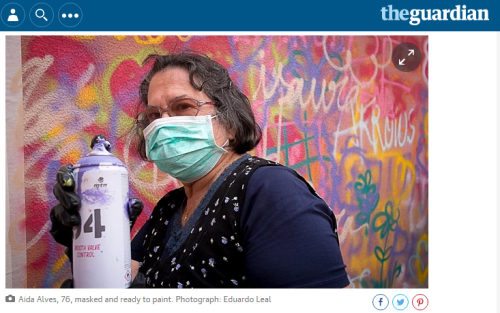
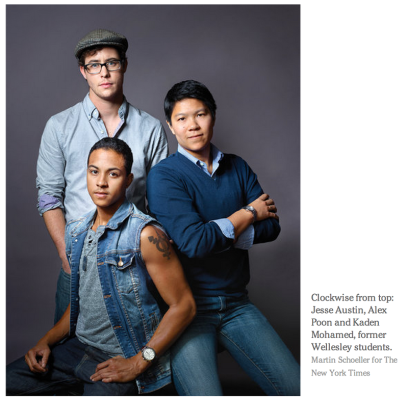




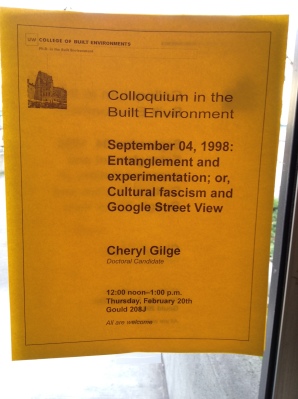










Ann Coulter is not a man. But you may be a transmisogynist.
Attention liberals and/or progressives. We gotta talk. We gotta talk about Ann Coulter. If you know and/or love trans women, first read this very carefully but then actively fight this in your social circles when it happens.
Whenever Ann Coulter spews nonsense, an extremely short fuse leads to some allegedly liberal/progressive person making a comment about her Adam’s apple, or referring to her as “he.” Sometimes they just short-circuit the entire process and call her a man. It’s all the same insult, though: cheap humor at the expense of trans women, who end up being collateral damage.
Most liberals/progressives do not see this connection. Therefore, let me break this down for you.
First, this is plain old misogyny. In point of scientific fact, all women have Adam’s apples. Look it up. Though they are generally less prominent than men’s, some women have larger or noticeable ones. (You’ll note also the extreme variation in men’s Adam’s apples.) Criticizing a (cis or trans) woman’s ideology by insulting her physical features is straight up misogynist bullshit.
Secondly, trans women are body-policed in this manner all the time. We are called men in order to shame us, mock us, and shut us up. Being called men dehumanizes us and invalidates us because that is not what we are. It is transphobia aimed specifically at trans women. It is misogyny specifically aimed at trans women, otherwise known as transmisogyny. This word violence has life-and-death consequences because it is directly linked to physical violence.
Trying to invalidate Ann Coulter by implying that she’s a man is this same transmisogynistic tactic. Using transmisogynistic tactics against any woman, cis or trans, is transmisogyny. It uses the idea of trans women as the insult itself. In fact, some commenters just flat out call her a tranny, using that word and trans womanhood as the insult.
So, following this, calling her a man as an insult is the same as calling her a trans woman as an insult. There is nothing wrong, negative, or insulting about being a trans woman; however, this tactic weaponises trans womanhood against us.
Ann Coulter doesn’t care what you call her; in fact she thrives on it. What is really happening then is that trans women are receiving the brunt of this because, first, the stigma of women being called men is acutely felt *EVERY DAY* by trans women. Not a day goes by that a trans woman’s womanhood and humanity are not questioned and mocked. This not only adds to that stigma but also normalizes it. It makes it seemingly legitimate in supposedly “liberal” and “progressive” discourse.
The problems should now be abundantly clear:
1) Calling out any woman’s ideology by attacking her appearance is an ad hominem, thus wrong. It is at the very minimum misogynist.
2) Calling any woman a man shows either a lack of understanding about trans women’s issues or a callous disregard for them. It is ignorant.
3) It is exactly the same tactic transphobes use against trans women. It is just as bad, then. It is transphobic… and specifically transmisogynistic… and, because trans women are women, it is misogynistic on top of all of that.
4) It is most likely even racist because trans women of color are especially affected by this type of attack. And plenty of cisgender women of color, who also do not fall into white supremacist and Eurocentric standards of feminine beauty and womanhood, are attacked this way as well. See http://transgriot.blogspot.com/2013/12/transmisogyny-isnt-just-being-aimed-at.html and follow the links.
5) Even if unintentionally and unwittingly, it is a virus spreading misunderstanding and hatred of trans women. It is enabling violence against trans women.
6) It is taking a topic, Ann Coulter, that has absolutely nothing to do with transgender and needlessly injecting transmisogyny.
7) Even if it turned out that she was trans, absolutely none of this would be negated. It would still be 210% wrong to do.
So cut this bullshit the fuck out. This hurts me and all my sisters. If you see others do this, tell them to cut it the fuck out.